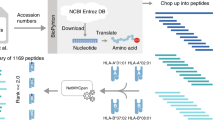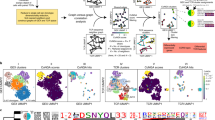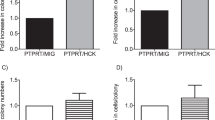Abstract
The recent detailed analysis of genes that undergo rearrangement in T cells has shown that the T-cell receptor genes encoding α and β-chains are involved in specific alterations in T-cell DNA analogous to the immunoglobulin genes1–9. A third type of gene, designated γ, has been isolated from mouse cytotoxic T lymphocytes10, and evidence suggests that the mouse displays very limited diversity in this gene system11, having only three variable-region (V) genes and three constant-region (C) genes12. The function of the so-called T-cell γ gene is unknown. We have isolated genomic genes encoding the human homologue of the mouse T-cell γ gene; as there is no evidence that this T-cell rearranging gene is anything to do with the T3 molecule, we have designated the human T-cell rearranging gene as TRG γ (ref. 13), to avoid confusion with the T3 γ-chain, and have shown that the gene locus maps to chromosome 7 in humans13. We now report that human DNA contains two tandemly arranged TRG γ constant-region genes about 16 kilobases apart. These two genes show multiple rearrangement patterns in a variety of T cells, including helper and cytotoxic/suppressor type, as well as in all forms of T-cell leukaemia. Our results indicate variability of this T-cell gene system in man compared with the analogous system in mouse.
This is a preview of subscription content, access via your institution
Access options
Subscribe to this journal
Receive 51 print issues and online access
$199.00 per year
only $3.90 per issue
Buy this article
- Purchase on Springer Link
- Instant access to full article PDF
Prices may be subject to local taxes which are calculated during checkout
Similar content being viewed by others
References
Chein, Y.-H. et al. Nature 312, 31–35 (1984).
Chein, Y.-H., Gascoigne, N. R. J., Kavaler, J., Lee, N. E. & Davis, M. M. Nature 309, 322–326 (1984).
Clark, S. P., Yoshikai, Y., Siu, G., Taylor, S., Hood, L. & Mak, T. W. Nature 311, 387–389 (1984).
Hedrick, S. M., Nielsen, A. E., Kavaler, J., Cohen, D. I. & Davis, M. M. Nature 308, 153–158 (1984).
Saito, H. et al. Nature 312, 36–40 (1984).
Sim, G. K. et al. Nature 312, 771–775 (1984).
Sims, J. E., Tunnacliffe, A., Smith, W. S. & Rabbitts, T. H. Nature 312, 541–545 (1984).
Siu, G. et al. Cell 37, 381–391 (1984).
Yanagi, Y. et al. Nature 308, 145–149 (1984).
Saito, H. et al. Nature 309, 757–762 (1984).
Kranz, D. M. et al. Nature 313, 752–755 (1985).
Hayday, A. C. et al. Cell 40, 259–269 (1985).
Rabbitts, T. H. et al. EMBO J. 4, 1461–1465 (1985).
Snodgrass, H. R., Dembic, Z., Steinmetz, M. & von Boehmer, H. Nature 315, 232–233 (1985).
Hamlyn, P. H. & Rabbitts, T. H. Nature 304, 135–139 (1983).
Sanger, F., Coulson, A. R., Barrell, B. G., Smith, A. J. H. & Roe, B. A. J. molec. Biol 143, 161–178 (1980).
Alitalo, K., Schwab, M., Lin, C. C., Varmus, H. E. & Bishop, J. M. Proc. natn. Acad. Sci. U.S.A. 80, 1707–1711 (1983).
Toyonaga, B., Yanagi, Y., Suciu-Foca, N., Minden, M. & Mak, T. W. Nature 311, 385–387 (1984).
Rabbitts, T. H. et al. EMBO J. (in the press).
Minowada, J. et al. Current Concepts in Human Immunobiology (eds Serrou, B. et al.) 75–84 (Elsevier, Amsterdam, (1982).
Greaves, M. F. et al. Leukaemia Res. 5, 281–299 (1981).
Southern, E. M. J. molec. Biol. 98, 503–517 (1975).
Vieira, J. & Messing, J. Gene 19, 259–268 (1982).
Bernheim, A., Berger, R. & Lenoir, G. Cancer Genet. Cytogenet. 3, 307–315 (1981).
Klein, E. et al. Cancer Res. 28, 1300–1310 (1968).
Author information
Authors and Affiliations
Rights and permissions
About this article
Cite this article
Lefranc, MP., Rabbitts, T. Two tandemly organized human genes encoding the T-cell γ constant-region sequences show multiple rearrangement in different T-cell types. Nature 316, 464–466 (1985). https://doi.org/10.1038/316464a0
Received:
Accepted:
Issue Date:
DOI: https://doi.org/10.1038/316464a0
This article is cited by
-
γδ T cells: origin and fate, subsets, diseases and immunotherapy
Signal Transduction and Targeted Therapy (2023)
-
Lack of expression of LMO2 clone SP51 identifies MYC rearrangements in aggressive large B-cell lymphomas
Virchows Archiv (2021)
-
Discrimination of T-cell subsets and T-cell receptor repertoire distribution
Immunologic Research (2014)
-
Transcriptomic analysis supports similar functional roles for the two thymuses of the tammar wallaby
BMC Genomics (2011)
-
Genome-wide association studies in the genetics of asthma
Current Allergy and Asthma Reports (2009)
Comments
By submitting a comment you agree to abide by our Terms and Community Guidelines. If you find something abusive or that does not comply with our terms or guidelines please flag it as inappropriate.



